Keeping your muscles strong can help to reduce your risk of heart and circulatory diseases. Try these 10 strength training exercises from the comfort of your own home.
You may have heard the expressions ‘strength training’ or ‘resistance training’ and are wondering what they mean. They’re simply a type of exercise that focuses on increasing your muscles’ strength, size, power and endurance.
“It’s any activity that makes your muscles work harder than usual,” says Jack Heseltine, a clinical exercise physiologist at Nuffield Health at St Bartholomew’s Hospital in London. He helps people with long-term conditions manage their health through exercise.
Strength exercises are easy to do at home. You can use resistance bands or weights such as dumbbells, or household items like water bottles. Or simply use your own bodyweight.
The benefits of strength training
Making muscles stronger through strength exercises helps us to do everyday tasks, like carrying heavy shopping more easily. It helps slow down bone and muscle loss as we age. And it improves our balance, reducing the risks of falls.
Keeping our muscles strong can also help to lower the risk of heart and circulatory disease and improve mental wellbeing, including anxiety and depression.
Want to get fit and healthy?
Sign up to our fortnightly Heart Matters newsletter to receive healthy recipes, new activity ideas, and expert tips for managing your health. Joining is free and takes two minutes.
I’d like to sign-up
Build your strength up slowly
NHS physical activity guidelines recommend doing strength-based exercise at least twice a week. Spread the sessions out, allowing at least a full day’s recovery between them.
Strength exercises should be done alongside the recommended 150 minutes a week of moderate intensity aerobic activity, such as brisk walking.
If you’re new to exercise you might want to check with your doctor before starting. Begin slowly and build up gradually.
As the exercises become easier, steadily increase how many you do, how often you do them, and how many times you repeat them in each session. Aim to repeat each exercise eight to 15 times.
Strength training at home
You can do these 10 exercises at home with no equipment. Want to make them more challenging? Add weights by using household items like water bottles or unopened food cans.
Strength training tips
- Do not hold your breath as this can increase your blood pressure.
- Breathe out with the effort of each exercise.
- Take a break if you cannot talk normally when doing the exercises.
- Make sure your movements are slow and controlled.
- Count for two seconds for the ‘lift’ or ‘push’ of each exercise.
- Count for two seconds for the ‘release’ of each exercise.
- Rest between exercises as needed.
10 strength exercises you can do at home
Heel raises
- Stand up straight with your legs slightly apart, toes facing forward and with equal weight in both feet.
- Hold onto a firm surface like a kitchen worktop or table for support, if needed.
- Keeping your knees and back straight, slowly lift both your heels off the floor so that your weight goes forward onto your toes.
- Slowly lower your heels back down to the floor.
Repeat the exercise eight to 15 times.
Tip: You can do this exercise sitting down to make it easier. With your feet flat on the floor, lift your heels off the floor, raising and lowering your knees.
Next step: Try doing this exercise with one leg at a time. Stand on one leg, bend your other leg at the knee and hold your foot off the floor. While holding onto something for support, raise and lower the heel of the leg you are standing on.
Sit to stand
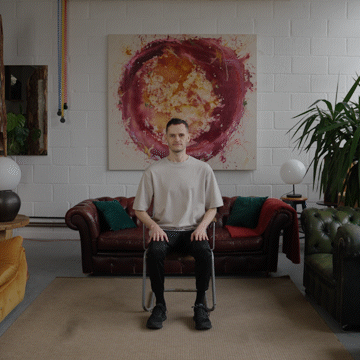
- Find a firm upright chair like a dining table chair. Sit slightly forward on the chair so you’re not resting on the back of the chair.
- Bend your legs 90 degrees at the knee and have them shoulder-width apart with your feet flat on the floor.
- From sitting, stand up slowly, then gradually sit back down.
- Repeat the exercise eight to 15 times.
Tip: Put your hands on the chair arms or on the top of your thighs to assist you, if you need some support. As you get stronger try to do the exercise without the use of your hands.
Next step: From standing, lower yourself towards the chair then stand up again without sitting down on the chair (this is called a squat).
Standing side leg lifts
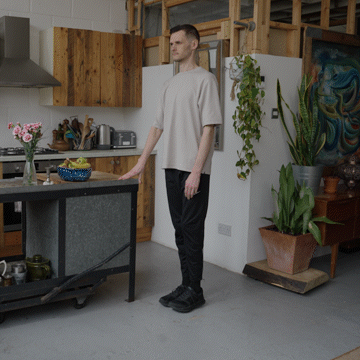
- Stand upright with your feet together, toes facing forward.
- Hold onto a firm surface like a kitchen worktop or table for support, if needed, or put your hands on your hips if your balance is good.
- Stand up tall and lift one leg off the floor and out to the side, keeping your leg straight and raising your leg no further than 30 degrees.
- Bring your leg back down to the starting position.
- Repeat eight to 15 times on each leg.
Tip: Make sure you keep standing up tall and do not lean away from the leg that you are moving.
For an easier version, do this exercise sitting down. Take one leg at a time and lift your leg off the chair slightly, and move your whole leg out to one side, tap your foot on the floor before returning the leg to the starting position.
Split squats
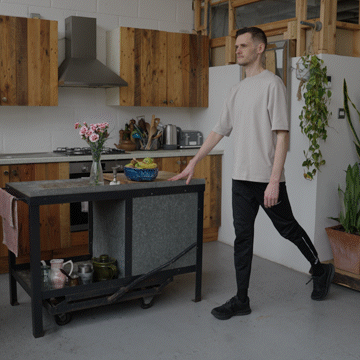
- Stand upright and hold onto a firm surface like a kitchen worktop or table. Turn your body so that the worktop or support is to your side.
- Take a large step back behind you with one foot, bend the knee of your rear leg then lower your body, dipping the knee of your leg towards the floor with your heel off the floor.
- Keep your chest up and your back straight throughout the exercise.
- Return to the starting position.
- Repeat on the same leg eight to 15 times then repeat the exercise with the other leg.
Tip: Start by dipping your knee just a few inches towards the floor. As you get stronger, dip your knee lower until it nearly reaches the ground.
Glute bridges
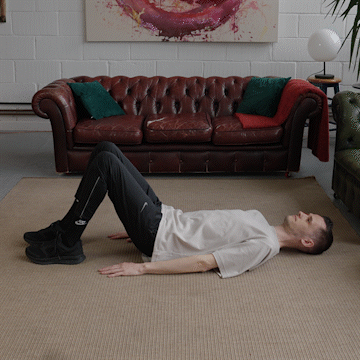
Only attempt this exercise if you feel confident getting up and down from the floor. Alternatively, you can do this exercise lying on a firm bed.
- Lie on your back with your knees bent up, your feet flat on the floor (or bed) and your arms by your side.
- Push down through your feet, keeping your shoulder blades in contact with the floor and push your hips up, lifting your bottom off the ground.
- Slowly lower back down to the ground.
- Repeat the exercise eight to 15 times.
Tip: When you first start this exercise, just try lifting your bottom an inch or two off the floor. As you get stronger, try to lift your bottom higher so that there is a straight line from your shoulders to your knees.
Tried this at home?
Tried these exercises at home? Did they help you? Email us your thoughts (and, if you like, photos of you trying them out) for a chance to be featured in the next magazine.
Seated forward punches
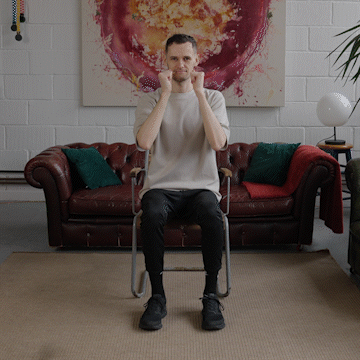
- Sit up straight on a firm chair (without using the back support) with your feet shoulder-width apart, feet flat on the floor.
- Make fists with your hands and hold them in front of your face.
- Punch one fist forward. As you bring this fist back in, punch the other fist forward.
- Repeat with each fist eight to 15 times, switching between your right and left arms.
Next step: Hold an unopened food can or small water bottle in each hand when doing this exercise. Then try doing forward punches while standing up.
Seated biceps curls
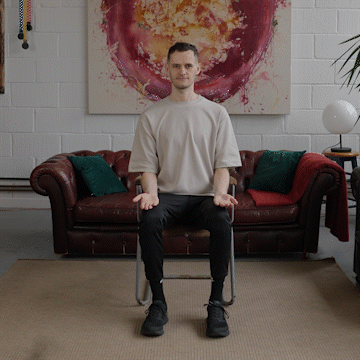
- Sit up straight on a firm chair (without using the back support) with your feet shoulder-width apart, feet flat on the floor.
- Put your hands on your thighs.
- Bend your elbows to take your hands towards your shoulders, then lower your hands back down and return to the starting position.
- Repeat eight to 15 times using either one arm at a time or both together.
Next step: Hold an unopened food can or small water bottle in each hand when doing this exercise. Then try doing bicep curls while standing up.
Seated upright rows
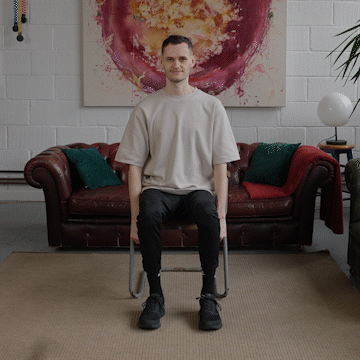
- Sit up straight on a firm chair (without using the back support) with your feet shoulder-width apart, feet flat on the floor.
- Put your arms straight down by your sides.
- Bend your elbows up and out to the sides until your hands are just below your shoulders (imagine you are lifting a shopping bag onto a table).
- Keep your neck and shoulder muscles relaxed throughout the exercise.
- Return to the starting position.
- Repeat eight to 15 times using either one arm at a time or both together.
Next step: Hold an unopened food can or small water bottle in each hand when doing this exercise. Then try doing uprights rows while standing up.
Chair dips
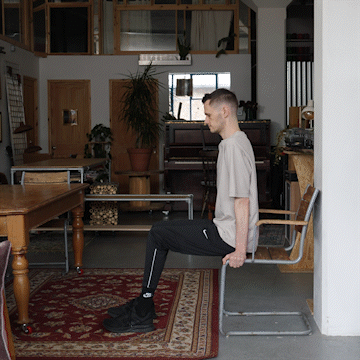
- Sit on a firm chair (ideally placed up against a wall) with your feet flat on the floor, shoulder-width apart.
- Place your hands on the front edge of the chair so your fingers can grip the chair seat.
- Shuffle your bodyweight forwards, and step both your feet a few inches away from the chair, keeping your knees and hips bent at 90 degrees.
- Lift your body off the chair using your arms.
- Let your elbows bend and dip your bottom just off the chair and down a few inches.
- Straighten your arms to bring your body back up so that your bottom is level with the chair.
- Repeat eight to 15 times.
Next step: As you get stronger, you can bend your elbows more and dip your bottom lower. You can also straighten your legs out to make the exercise more challenging.
Wall push ups
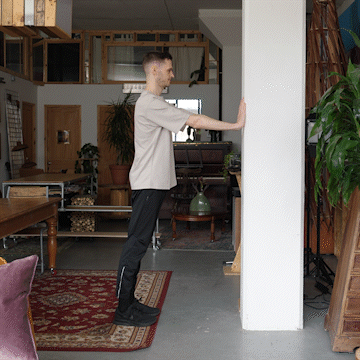
- Face a wall, standing one arm’s length away.
- Place your hands flat on the wall at shoulder height and slightly wider than your shoulders.
- Bend your elbows and lean your body in towards the wall, then straighten your arms and push yourself back to the upright starting position.
- Keep your back and knees straight with your feet flat on the floor throughout the exercise.
- Repeat eight to 15 times.
Next step: Try using a lower surface such as the kitchen worktop or a table, which makes the exercise more challenging by increasing the effect of gravity.
Meet the expert

Jack Heseltine is clinical exercise physiologist at Nuffield Health at St Bartholomew’s Hospital. He helps people with long-term conditions manage their health through exercise.
What to read next…
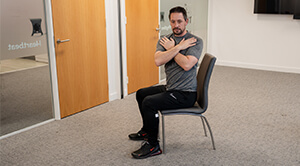
Published 18 June 2024



